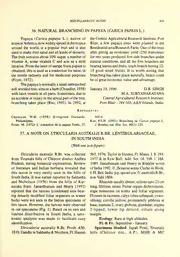
A note on Utricularia australis R.Br. Lentibulariaceae, in South India PDF
Preview A note on Utricularia australis R.Br. Lentibulariaceae, in South India
MISCELLANEOUS NOTES 439 36. NATURAL BRANCHING IN PAPAYA (CARICA PAPAYA L.) Papaya (Carica papaya L.), native of the Central Agricultural Research Institute, Port tropical America, nowwidely spread in thetropics Blair, a few papaya trees were planted in the around the world, is a popular fruit and is also Residential area/Research Farm. One ofthe trees used to make fruit salad and all kinds ofdesserts. after giving an economic yield (250 fruits/tree) The fruit contains about 10% sugar, a number of for two years produced five side branches under vitamin A, some vitamin C and acts as a mild natural conditions, and all the five branches are laxative. From the latex ofunripe fruits papain is bearing leaves and fruits, (eachbranchhaving 12- obtained; this is used as a tenderizer for meat, in 15 good sized fruits). It is worth noting that the textile industry and for medicinal purposes branching has taken place naturally, hence could (Foyet, 1972). be of great economic value and advantage. Thepapayaisnormally a small unbranched soft wooded tree, almost aherb (Chandler, 1958) January 19, 1996 D.B, SINGH SURYANARAYANA with latex vessels in all parts. Sometimes, due to M.A. an accident or injury in the apical part ofthe tree, CentralAgricultural Research Institute , A&N branching takes place (Rao, 1991). In 1992, at Port Blair - 744 010 Islands India. , , References Chandler, W.H. (1958): Evergreen Orchards, 303-6. Philadelphia. Rao, P.S.N. (1991): Branching in Carica papaya L. Foyet, M. (1972): L’ extraction de le papain Fruits, 27, J. Bombay not. Hist. Soc. 90(1): 123. 37. A NOTE ON UTRICULARIA AUSTRALIS R.BR. LENTIBULARIACEAE, IN SOUTH INDIA (With one text-figure ) Utricularia australis R.Br. was collected 563. 1976; Taylor in Steenis, FI. Males. 1. 8: 299. from Tirumala hills of Chittoor district Andhra 1977 & in Kew Bull. Add. Ser. 14: 598. f. 184. Pradesh, during botanical explorations. Review 1989. Janadhanam and Henry in Bladder worts of literature and Indian herbaria revealed that ofIndia 1992. U.flexuosasensu Clarke in Hook, this taxon is very rarely seen in the hills of f. FI. Brit. India, p.p. quoad syn. U. australisR.Br., South India. It was earlier reported by Saldanha non Vahl 1804. and Nicholson (1976) from the hills of Kar- Rhizoidsusually absent; stolons upto25 cm nataka State. Janardhanam and Henry (1992) long, filiform, terete. Foliar organs dichotomous, reported that the turions (condensed axis bear- traps numerous on nodes and foliar segments. ing densely modified foliar segments as winter Flowers in racemes, calyx lobes subequal, ovate- buds) were not seen in the Indian specimens of oblong; corolla yellow, prominently gibbous at this taxon. However, the turions were observed base; stamens2; ovary globose, glandular; stigma in our specimens (Fig. 1). Based on its rare and 2-lipped, lower lip deltoid, ciliate along limited distribution in South India, a taxo- margin. nomic analysis was made to facilitate easy Ecology: Rare at high altitudes. & identification. FI. Fr.: September - January. Utricularia australis R.Br. Prodr. 430. Specimens Studied: Japali Pond, Tirumala & MHR & MC 1810; Gandhi in Saldanha Nicolson, FI. Hassan hills (Chittoor dist., A.P.). 440 JOURNAL, BOMBAYNATURAL HIST. SOCIETY, Vol. 94 (1997) Fig. 1. Utricularia australis R. Br. A. Habit; B. Foliar organ; C. Turion; D. Trap; E. Bract; F. Flower; G. Calyx; H. Corolla; I. Stamen; J. Pistil. MISCELLANEOUS NOTES 441 14505; Arkalgud (Hassan dist., Karnataka), CJS June 15, 1996 M. CHENNA KESAVULU 11079. M. HEMAMBARA REDDY VENKATA RAJU R.R. Acknowledgements Department ofBotany, We are grateful to theCouncil ofScientific Sri Krishnadevaraya University, and Industrial Research, New Delhi, for financial Anantapur-515 003, assistance. Andhra Pradesh. 38. FIRST RECORD OF PERISTYLUS MONTICOLA (RIDL.) SEIDENF (ORCHIDACEAE) FOR INDIA FROM ANDAMANS Peristylusmonticola (Ridl.) Seidenf.previously 1992. known from Indonesia, the Philippines, New Terrestrial herbs, c. 50cm high. Leavesoblong- Guinea and Malaya has been located from lanceolate, 3-10 x 1-3 cm. Spikes 20-40 cm long. Andaman Islands and reported for the first time Rowers small, greenish-yellow. Spur as long as the from India. The genusPeristylusBl. holds over 70 sepals and petals. species of which over 28 species occur in India Rare, in moss-covered hilly slopes, grows (Sathish Kumar and Manilal, 1994) and 3 species along with Actinostachys digitata (L.) Wall, ex viz. P mannii (Reichb. f.) Mukerjee,P monticola Hook., Eria muscicola (Lindl.) Lindl., Porpax (Ridl.) Seidenf and P. parishii Reichb. f. in elwesii (Reichb. f.) Rolfe, etc. Andaman-Nicobar Islands. P. monticola was Specimen examined: India: North Andaman, collected by me from Saddle Peak of North Lower-Saddle Peak; + 600 m, 24.xi.1993, P.V. Andaman andgrown in mypersonal collection. The Sreekumar 16436 (PBL) occurrence ofthis rare species in Andaman Island extends its known range of distribution to June 15, 1996 P.V. SREEKUMAR India. Botanical Survey ofIndia, Peristylus monticola (Ridl.) Seiden. & Dansk Andaman & Nicobar Circle Bot. Arkiv. 31, 3: 35. t. 13. 1977; Seidenfaden & Post Box No. 692, Haddo, Wood Orch. Malay Pen. Singapore 103. 42. 104. Port Blair 744102. t. Reference Sathish Kumar, C. & K.S. Manilal (1994): A catalogue of Indian Orchids. Bishen Singh & Mahendra Pal Singh, Dehradun. 39. ON THE PERIANTH BRISTLES IN SCHOENOPLECTUS CORYMBOSUS (ROTH EX ROEM. & SCHULT.) RAYNAL J. (With one text-figure) The genusSchoenoplectus is differentiated genera. The characteristics of this genus are the from the other genera of Cyperaceae by a spirally arranged glumes and the style not complex ofdifferentcharacters. There is no single articulated with the ovary. However, these are common character in all the species ofthis genus common characters in many genera of by which it can be separated from the other Cyperaceae, hence it is not a natural genus. A
